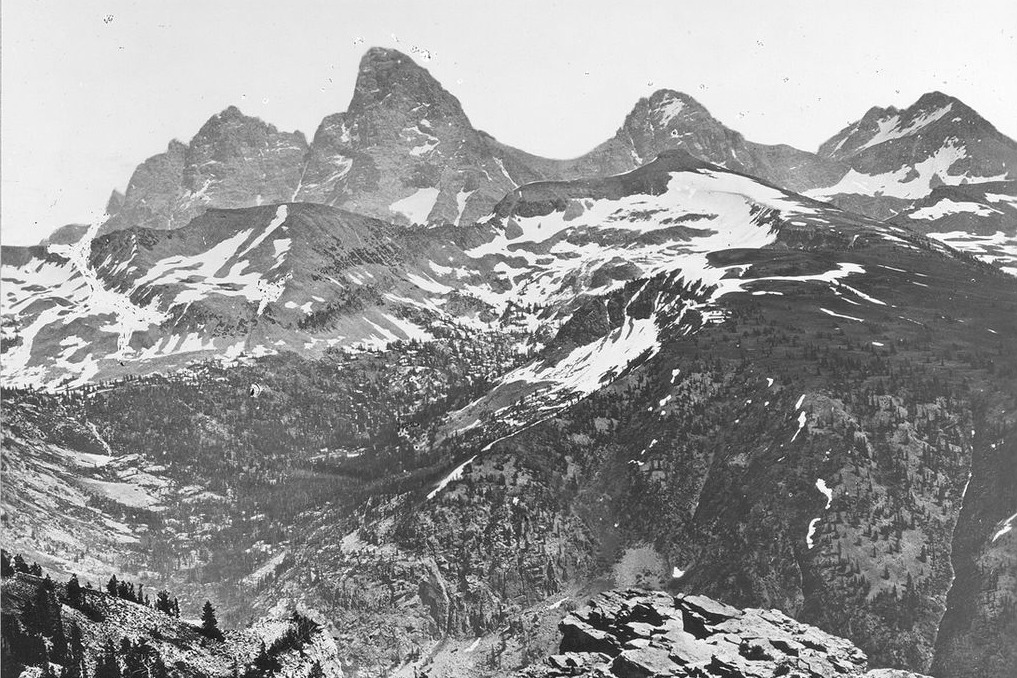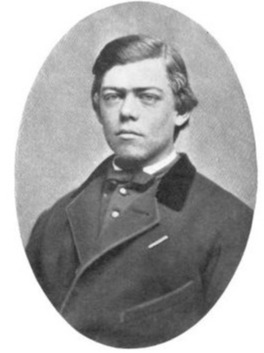First Ascents of August - History of the amazing firsts of our iconic peaks
FIRST
ASCENTS OF
AUGUST
In a time before accurate weather forecasting, cleared forest roads, technical climbing gear and trail maps these brave individuals driven by something deep within set out to climb some of the most iconic peaks in the country. August just happened to be the most popular time for many. We went through years of history, news clippings, lengthy articles, and contentious claims to bring you these unique stories.
We fully acknowledge that these are the documented first ascents by europeans and many of these peaks were explored and possibly summited by the native people living in around these majestic peaks. With that, let's dig in to what has been documented starting in early August and progressing through the month.

Mt. Hood from Government Camp
AUGUST 6, 1857
MT. HOOD
FIRST ASCENT
Thomas Dryer, founder of The Oregonian newspaper claimed to have been the first to summit Mt. Hood along with several other individuals on August 25, 1854 . However, Dryers account of the ascent which he published in the paper had many flaws, including citing the presence of volcanic vents at the summit. His claims have been disputed by many historians and is believed that he never reached the true summit but was several hundred yards short. Three years later on August 6, 1857 Henry Pittock at 22 years old would lead a team of four (L.J. Powell, William S. Buckley, W. Lyman Chittenden, and James Deardorff) to the summit of Mt. Hood via The Old Chute route. Pittock’s description of the mountain and landmarks helped bolster his claim of being the first to reach the true summit. A member of Pittocks team would later publish an article in a rival paper disputing Dryers claim. Dryer shot back in an editorial disputing Pittocks story and so began one of the great beefs of the 19th century.

Thomas Dryer

Henry Pittock
Did we mention that Pittock was employed by The Oregonian when he first summited the mountain? He would get the last laugh when he later became Dryers successor and took control of the newspaper in 1860. Pittock would climb the mountain three more times in his life and became a founding member of the Mazamas, a non-profit mountaineering educational organization founded in 1894 that is still climbing strong today.

Henry Pittock in 1894

The founding Mazamas climb in 1894
A great video from our friends at OPB dives into the history of climbing Mt. Hood in depth and the amazing accomplishments of the women and men of the Mazamas below:

Mt. Washington
AUGUST 7, 1870
MT. WASHINGTON
FIRST ONE-LEGGED ASCENT
On August 7, 1932 Raymond Welch became the first one legged person to climb Mt. Washington. This may not be your classic first ascent story but we thought it was impressive and deserved recognition. Raymond lost his leg and hip in a childhood sledding accident and due to the loss of his hip he was unable to wear a prosthetic leg. He would rely on a crutch and cane during his climb. He made the ascent to the summit via the Cogwheel Railway and completed the climb in four hours and fifteen minutes. He would go on to climb the mountain again on July 2, 1933 this time up Tuckerman Ravine.
For those wondering, the first true documented climb was in early June 1642 after a 18 day journey by Darby Field and his team.

Cogwheel Railway

Raymond Welch at the summit

NYT Article

Tahoma / Mt. Rainier, 1900
AUGUST 10, 1890
MT. RAINIER
FIRST FEMALE ASCENT
Inspired by Van Trump who first reached the summit in 1870, Fay Fuller would become the first woman to make the ascent on August 10, 1890. The twenty year old journalist and teacher from Yelm, Washington would reach the summit accompanied by Van Trump, Hazard Stevens and two others. She used charcoal to blacken her face on the climb to protect herself from the sun, wore goggles, a thick flannel bloomer and boys shoes. The group left from Camp Muir at 4:30am and would reach the summit at 4pm. Having reached the peak so late in the day the group decided it was best to spend the night at the summit. They would shelter in an ice cave which had been formed by steam vents as well. At 6:30am the next morning the group successfully descended down icy slopes through gale winds. Fay would go on to be a founding member of the Washington Alpine Club and the Mazamas. Mount Rainier's Fay Peak is now named after her.
“It was a heavenly moment. Words cannot describe the scenery and beauty; how could they speak for the soul?” - Fuller

Fay Fuller
Fay would go on to be a founding member of the Washington Alpine Club and the Mazamas. Mount Rainier's Fay Peak is now named after her.

Mazama women, 1896

Tetons, 1872
August 11, 1898
GRAND TETON
FIRST ASCENT
On August 11, 1898 William Owen, Franklin Spalding, Frank Petersen, and John Shive would be the first to document their climb to the summit via their own route, now the 5.4 Owen–Spalding.

Owen - Spalding Route, 1898

William Owen, John Shive, Frank Petersen at the summit
Who reached the summit first is still up for debate and shrouded in controversy. In July 1872, Nathaniel Langford, James Stevenson and members of the 14-person Hayden Expedition claimed to have summited the Grand Teton. However, when Willam Owen and his expedition reached the summit some 26 years later they saw no sign of a previous ascent. This was odd since members of the Langford and Stevenson expeditions typically built cairns at the summit. After reviewing Langfords description and sketches of the climb many believe it matches that of The Enclosure, a side peak of the Grand Teton.

William Owen

Frank Spalding
Although we may never definitively know who was first to reach the top, we do know Owen and Spalding were the first to document their summit. A plaque commemorating their ascent would be placed on the summit in 1929 only to be stolen in 1977, further adding to the controversy.

Owen (middle) and the plaque commemorating his first ascent

Owen at 64 years old, Grand Teton summit, August 1925

Mount Shasta
AUGUST 14, 1854
MT. SHASTA
FIRST ASCENT
Elias Pierce of Yreka California would become the first person to reach the summit of Mount Shasta on August 14, 1854 after several earlier failed attempts. Elias was originally from West Virginia but moved to California during the gold rush. He and a group of eight climbers left camp on the south side of the mountain that morning and navigated rough terrain. As later described they “Were obliged in many places to climb from crag to crag as best we could. The least misstep, or the detaching of the smallest piece of rock upon which we were obliged to cling for life.” They would reach the summit at 11:30am and by 12pm they planted an American flag, had some “refreshments” and began the descent.

Elias Pierce
The first group of women to climb Mt. Shasta would led by Harriette Eddy and Mary Campbell McCloud who would reach the summit on September 16, 1856. Leaving from their camp at 6am it would take them ten hours to reach the summit at around 4pm. The group would plant a flag and leave a bible at the peak before making their way back to camp, arriving back at 10pm.

Mount Baker from Oak Bay, B.C.
AUGUST 17, 1868
MT. BAKER
FIRST ASCENT
After two previous unsuccessful attempts to climb Mt. Baker to the Grant's Peak summit, Edmund Coleman would make his first successful mission on August 17, 1868. The group of five climbers would be in part guided by four members of the Lummi Reservation. The group left from Nooksack on August 7th, it would take the group 14 days to complete their mission. They packed light and only brought canvas tents, rubber tarps, pans, ropes and wool socks. Their menu was even more basic, consisting of only tea, bread, and bacon. Leaving their final camp at 5am the morning of the 17th they would reach the summit at 4pm to plant a flag and leave a copper plate with their names on it. Coleman would make it back home by the 22nd to telegraph his story out to the world.

Climbers in the forest

Extinct crater, showing Mount Grant

Mount Baker, viewed from British Columbia
"After we sang an appropriate patriotic song. We then shook hands, and, a flask of brandy being produced, the names of all those interested in the expedition were duly honored." - COLEMAN

The group planting a flag at the summit, Grants Peak

Mt. Rainier
AUGUST 17, 1870
MT. RAINIER
FIRST ASCENT
On August 17, 1870 Philemon Beecher Van Trump and Hazard Stevens would become the first documented party to reach the summit of Tahoma, know today as Mt. Rainier. He was led part of the way by a Native American guide and hunter, Sluiskin. They set up camp at what is today known as Sluiskin Falls the day before making their daring climb. After hiking for 11 hours the group reached the summit at 5pm. Unprepared for a multi day trip, they were was forced to spend the night on top of the mountain, luckily the team of climbers located a small cavern from which jets of hot steam and smoke could be seen. As they thought they would complete the round trip in one day they did not bring extra food or blankets. They survived by spending the night in the warmth of the cave. They left a brass plate containing their names on the summit and began their descent. Van Trump would suffer a minor injury during the descent after falling on sharp rocks but would ultimately return safely to camp.

Hazard Stevens

Philemon Van Trump

Sluiskin
Van Trump would make three more trips to the summit during his life. He would guide John Muir, the founder of the Sierra Club on a trip to the summit in 1888. They would go on to work together in advocating for the national park status of Mount Rainier which came to be in 1899. The Van Trump Park, Creek, and Glacier on Mount Rainier are all named after him.

Van Trump portrait by Asahel Curtis

Hazard and Van Trump many years later

Marianne Sinclair & Ty Kearney
AUGUST 17, 1947
MT. HOOD
FIRST MOUNTAIN BIKE RIDE
Mazamas Ty Kearney and Marianne Sinclair set out to be the first to ride a bike on top of Mt Hood. Joined by nine friends they carried a disassembled bicycle to the summit of Mt. Hood. They reassembled the bike at the top and took it for a ride! It may not have worked out as well as they planned but did make for quite the story.
Photo Credit: Mazama Library & HIstorical Collections, Kearney Collection


AUGUST 23, 1868
LONGS PEAK
FIRST ASCENT
The first recorded ascent of Longs Peak in Colorado was accomplished by John Wesley Powell on August 23, 1868. He would reach the summit accompanied by six other men. The group climbed to the summit via the south side. On the day of the summit they started at around 6 o’clock and would reach the summit by ten o’clock. The team would leave a flag atop the mountain and make their way safely down the mountain and returned home the following day. The expedition took five days in total.


Maroon Bells
AUGUST 25, 1908
MAROON PEAK
FIRST ASCENT
The first recorded ascent of Maroon Peak was completed by Percy Hagerman on August 25, 1908. He rode a horse for the first three and a half miles up Maroon Pass trail and then to the summit by foot via the southwest face. It would take him eleven hours to complete the round trip. He would go on to become a distinguished artist and serve as president of the Fine Arts Center Board. Both Hagerman Peak and Pass are named after him.

Percy Hagerman

Mt. Hood 1904
AUGUST 26, 1867
MT. HOOD
FIRST FEMALE ASCENT
Fannie Case from and Mary Robinson would become the first women to reach the summit of Mt. Hood on August 26, 1867. They would be accompanied by David Powell and John Garrison. An article of their story would appear in The Oregonian years later.

Case daughters, Fannie Case far right, 1870

Mount St. Helens from Spirit Lake
AUGUST 26, 1853
MOUNT SAINT HELENS
FIRST ASCENT
On August 26, 1853 the Oregonian editor Thomas J. Dryer would become the first documented person to summit Mount St. Helens along with three others. The same Dryer who would later be disputed about his claim to have first reached the summit of Mt. Hood. The group would ascend up the south side on the 25th and make camp for the night. They would reach the summit the next afternoon, which was 1,300 feet higher than it is today. Upon reaching the summit Dryer observed how “The smoke was continually issuing from its mouth, giving unmistakable evidence that the fire was not extinguished”. A observation that would prove true on May 18, 1980. The group would build a pyramid of loose stones and then safely return to camp at 4pm. It would take them four more days to reach home. The Dryer Glacier is now named in his honor.

Climbing routes, before the 1980 eruption

Thomas Dryer

Grand Teton, August 1872
AUGUST 27, 1923
GRAND TETON
FIRST FEMALE ASCENT
Eleanor Davis of Colorado would become the first woman to reach the summit accompanied by Albert Ellingwood. As if that wasn't enough, they would make another first recorded climb two days later summiting the South Teton. Eleanor would also be credited for making the first ascent of Crestone Needles in 1916.

Eleanor Davis (seated) at Sentinel Rocks
August was a special month for many of the peaks that inspire us here at North. We raise a glass to the women and men that set the routes that we all aspire to follow today. Cheers!

